INTL 702 - International Banking and Finance: India Expansion Project
VerifiedAdded on 2023/05/30
|6
|1177
|167
Project
AI Summary
This project provides a detailed analysis of international banking and finance, focusing on a Canadian client's expansion into the Indian market. The project explores funding sources, recommending debt and equity financing options, and suggests obtaining a loan from a local Indian bank due to favorable interest rates. It examines the impact of currency fluctuations, considering the appreciation and depreciation of the Canadian dollar and the Indian rupee on loan amounts and business income. The analysis highlights the importance of understanding foreign exchange implications for successful international business ventures, offering insights into how currency movements affect loan repayments and the translation of business profits. The project provides a comprehensive overview of the financial considerations involved in international expansion, offering valuable recommendations for the client's strategic decision-making.
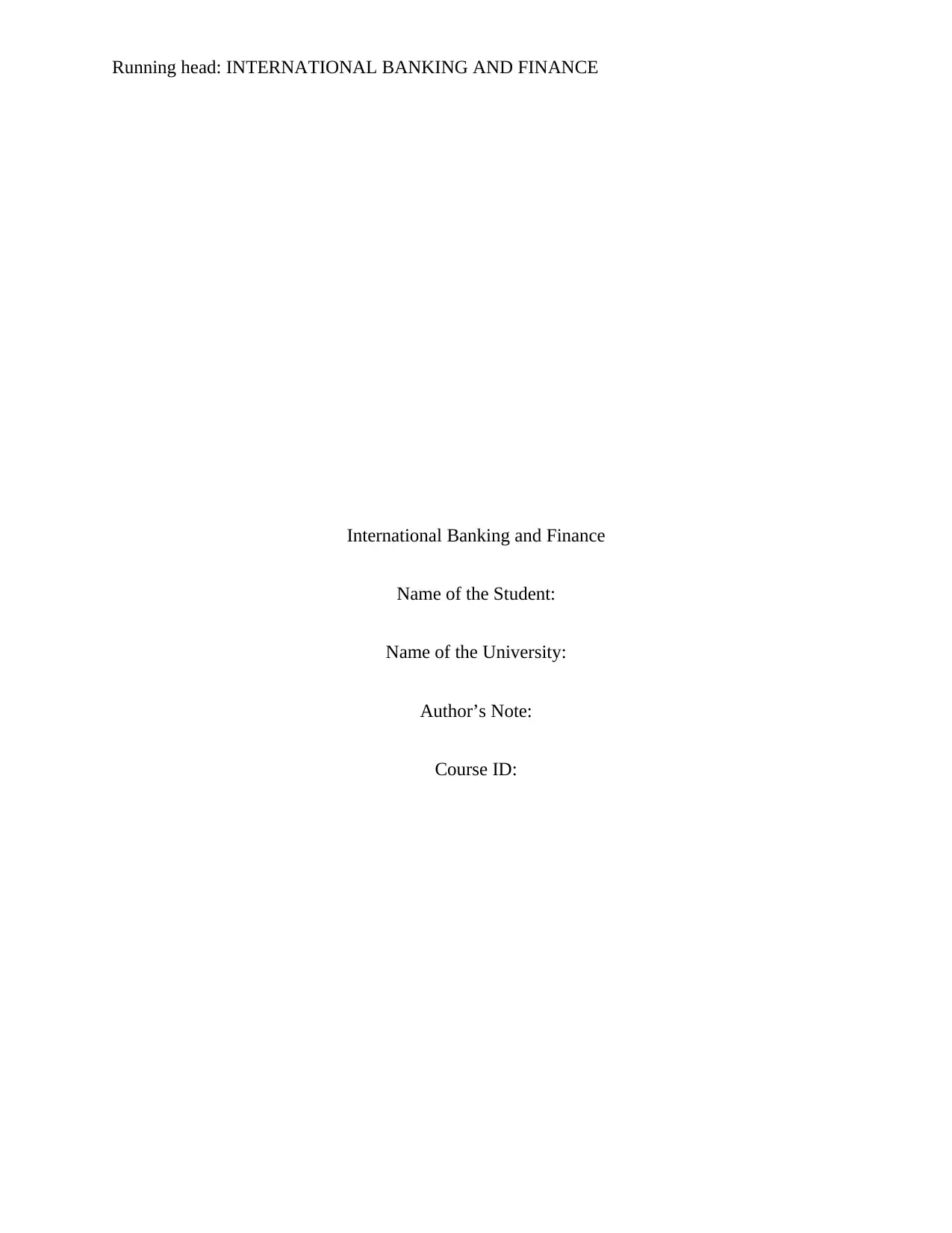
Running head: INTERNATIONAL BANKING AND FINANCE
International Banking and Finance
Name of the Student:
Name of the University:
Author’s Note:
Course ID:
International Banking and Finance
Name of the Student:
Name of the University:
Author’s Note:
Course ID:
Paraphrase This Document
Need a fresh take? Get an instant paraphrase of this document with our AI Paraphraser
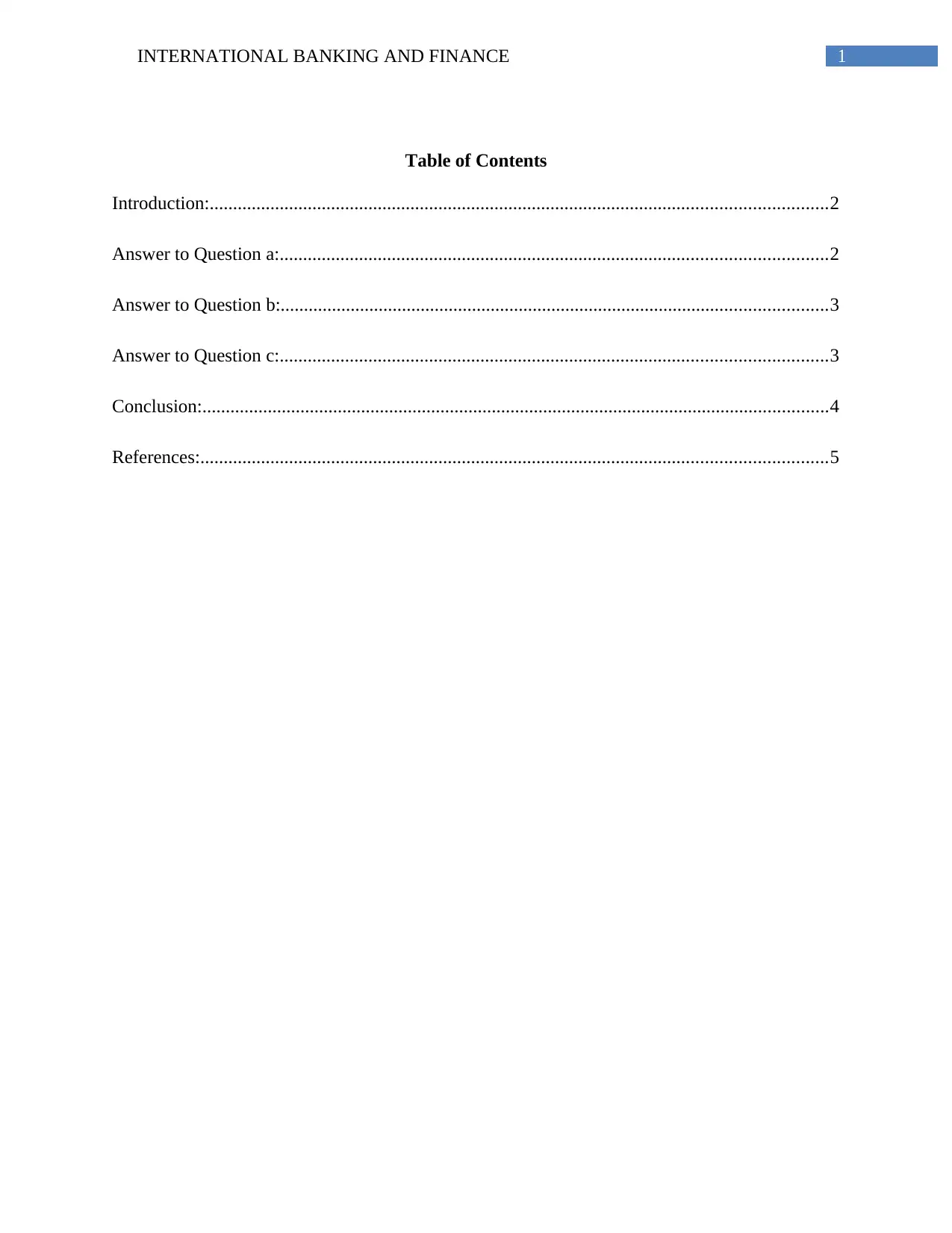
1INTERNATIONAL BANKING AND FINANCE
Table of Contents
Introduction:....................................................................................................................................2
Answer to Question a:.....................................................................................................................2
Answer to Question b:.....................................................................................................................3
Answer to Question c:.....................................................................................................................3
Conclusion:......................................................................................................................................4
References:......................................................................................................................................5
Table of Contents
Introduction:....................................................................................................................................2
Answer to Question a:.....................................................................................................................2
Answer to Question b:.....................................................................................................................3
Answer to Question c:.....................................................................................................................3
Conclusion:......................................................................................................................................4
References:......................................................................................................................................5
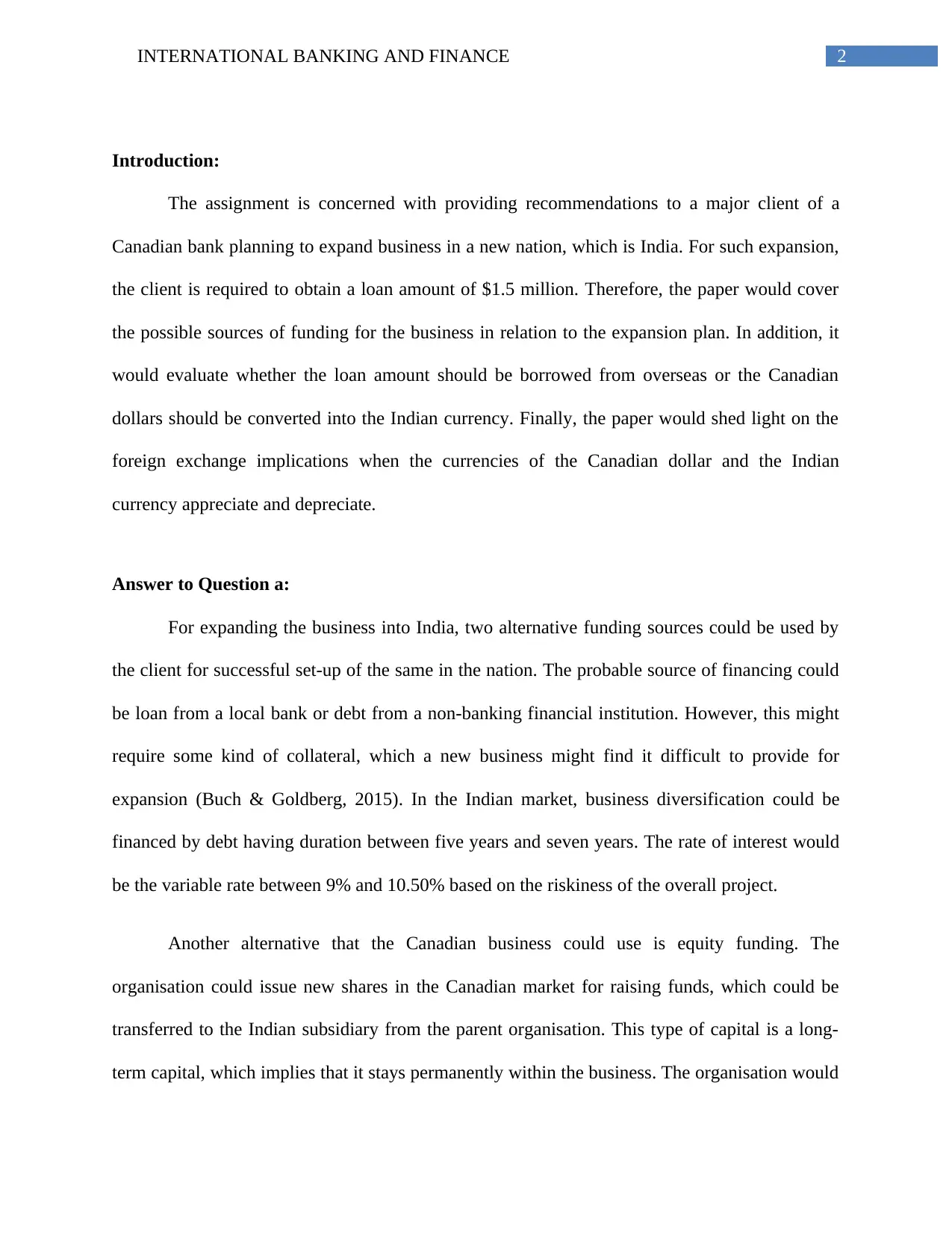
2INTERNATIONAL BANKING AND FINANCE
Introduction:
The assignment is concerned with providing recommendations to a major client of a
Canadian bank planning to expand business in a new nation, which is India. For such expansion,
the client is required to obtain a loan amount of $1.5 million. Therefore, the paper would cover
the possible sources of funding for the business in relation to the expansion plan. In addition, it
would evaluate whether the loan amount should be borrowed from overseas or the Canadian
dollars should be converted into the Indian currency. Finally, the paper would shed light on the
foreign exchange implications when the currencies of the Canadian dollar and the Indian
currency appreciate and depreciate.
Answer to Question a:
For expanding the business into India, two alternative funding sources could be used by
the client for successful set-up of the same in the nation. The probable source of financing could
be loan from a local bank or debt from a non-banking financial institution. However, this might
require some kind of collateral, which a new business might find it difficult to provide for
expansion (Buch & Goldberg, 2015). In the Indian market, business diversification could be
financed by debt having duration between five years and seven years. The rate of interest would
be the variable rate between 9% and 10.50% based on the riskiness of the overall project.
Another alternative that the Canadian business could use is equity funding. The
organisation could issue new shares in the Canadian market for raising funds, which could be
transferred to the Indian subsidiary from the parent organisation. This type of capital is a long-
term capital, which implies that it stays permanently within the business. The organisation would
Introduction:
The assignment is concerned with providing recommendations to a major client of a
Canadian bank planning to expand business in a new nation, which is India. For such expansion,
the client is required to obtain a loan amount of $1.5 million. Therefore, the paper would cover
the possible sources of funding for the business in relation to the expansion plan. In addition, it
would evaluate whether the loan amount should be borrowed from overseas or the Canadian
dollars should be converted into the Indian currency. Finally, the paper would shed light on the
foreign exchange implications when the currencies of the Canadian dollar and the Indian
currency appreciate and depreciate.
Answer to Question a:
For expanding the business into India, two alternative funding sources could be used by
the client for successful set-up of the same in the nation. The probable source of financing could
be loan from a local bank or debt from a non-banking financial institution. However, this might
require some kind of collateral, which a new business might find it difficult to provide for
expansion (Buch & Goldberg, 2015). In the Indian market, business diversification could be
financed by debt having duration between five years and seven years. The rate of interest would
be the variable rate between 9% and 10.50% based on the riskiness of the overall project.
Another alternative that the Canadian business could use is equity funding. The
organisation could issue new shares in the Canadian market for raising funds, which could be
transferred to the Indian subsidiary from the parent organisation. This type of capital is a long-
term capital, which implies that it stays permanently within the business. The organisation would
⊘ This is a preview!⊘
Do you want full access?
Subscribe today to unlock all pages.

Trusted by 1+ million students worldwide
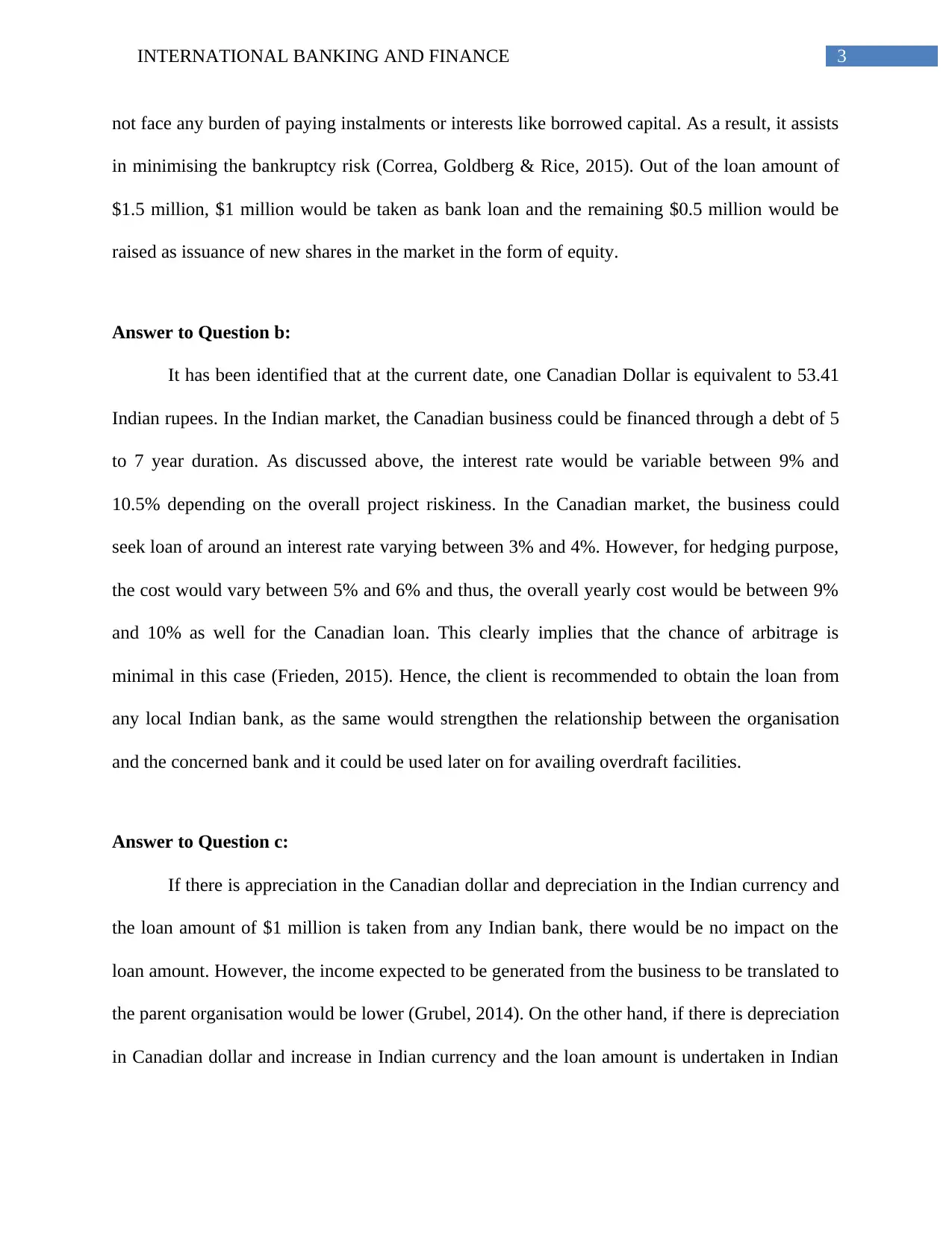
3INTERNATIONAL BANKING AND FINANCE
not face any burden of paying instalments or interests like borrowed capital. As a result, it assists
in minimising the bankruptcy risk (Correa, Goldberg & Rice, 2015). Out of the loan amount of
$1.5 million, $1 million would be taken as bank loan and the remaining $0.5 million would be
raised as issuance of new shares in the market in the form of equity.
Answer to Question b:
It has been identified that at the current date, one Canadian Dollar is equivalent to 53.41
Indian rupees. In the Indian market, the Canadian business could be financed through a debt of 5
to 7 year duration. As discussed above, the interest rate would be variable between 9% and
10.5% depending on the overall project riskiness. In the Canadian market, the business could
seek loan of around an interest rate varying between 3% and 4%. However, for hedging purpose,
the cost would vary between 5% and 6% and thus, the overall yearly cost would be between 9%
and 10% as well for the Canadian loan. This clearly implies that the chance of arbitrage is
minimal in this case (Frieden, 2015). Hence, the client is recommended to obtain the loan from
any local Indian bank, as the same would strengthen the relationship between the organisation
and the concerned bank and it could be used later on for availing overdraft facilities.
Answer to Question c:
If there is appreciation in the Canadian dollar and depreciation in the Indian currency and
the loan amount of $1 million is taken from any Indian bank, there would be no impact on the
loan amount. However, the income expected to be generated from the business to be translated to
the parent organisation would be lower (Grubel, 2014). On the other hand, if there is depreciation
in Canadian dollar and increase in Indian currency and the loan amount is undertaken in Indian
not face any burden of paying instalments or interests like borrowed capital. As a result, it assists
in minimising the bankruptcy risk (Correa, Goldberg & Rice, 2015). Out of the loan amount of
$1.5 million, $1 million would be taken as bank loan and the remaining $0.5 million would be
raised as issuance of new shares in the market in the form of equity.
Answer to Question b:
It has been identified that at the current date, one Canadian Dollar is equivalent to 53.41
Indian rupees. In the Indian market, the Canadian business could be financed through a debt of 5
to 7 year duration. As discussed above, the interest rate would be variable between 9% and
10.5% depending on the overall project riskiness. In the Canadian market, the business could
seek loan of around an interest rate varying between 3% and 4%. However, for hedging purpose,
the cost would vary between 5% and 6% and thus, the overall yearly cost would be between 9%
and 10% as well for the Canadian loan. This clearly implies that the chance of arbitrage is
minimal in this case (Frieden, 2015). Hence, the client is recommended to obtain the loan from
any local Indian bank, as the same would strengthen the relationship between the organisation
and the concerned bank and it could be used later on for availing overdraft facilities.
Answer to Question c:
If there is appreciation in the Canadian dollar and depreciation in the Indian currency and
the loan amount of $1 million is taken from any Indian bank, there would be no impact on the
loan amount. However, the income expected to be generated from the business to be translated to
the parent organisation would be lower (Grubel, 2014). On the other hand, if there is depreciation
in Canadian dollar and increase in Indian currency and the loan amount is undertaken in Indian
Paraphrase This Document
Need a fresh take? Get an instant paraphrase of this document with our AI Paraphraser
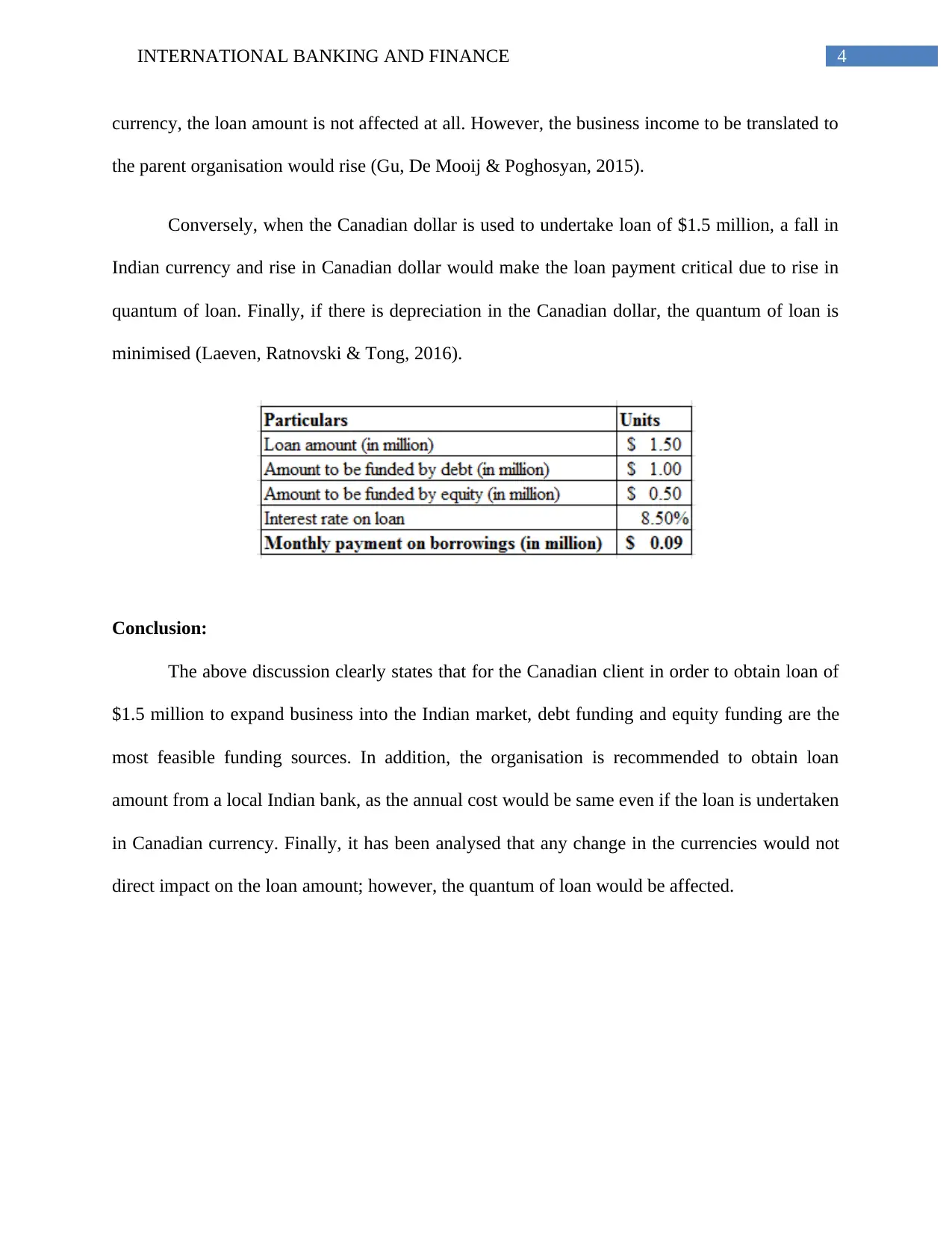
4INTERNATIONAL BANKING AND FINANCE
currency, the loan amount is not affected at all. However, the business income to be translated to
the parent organisation would rise (Gu, De Mooij & Poghosyan, 2015).
Conversely, when the Canadian dollar is used to undertake loan of $1.5 million, a fall in
Indian currency and rise in Canadian dollar would make the loan payment critical due to rise in
quantum of loan. Finally, if there is depreciation in the Canadian dollar, the quantum of loan is
minimised (Laeven, Ratnovski & Tong, 2016).
Conclusion:
The above discussion clearly states that for the Canadian client in order to obtain loan of
$1.5 million to expand business into the Indian market, debt funding and equity funding are the
most feasible funding sources. In addition, the organisation is recommended to obtain loan
amount from a local Indian bank, as the annual cost would be same even if the loan is undertaken
in Canadian currency. Finally, it has been analysed that any change in the currencies would not
direct impact on the loan amount; however, the quantum of loan would be affected.
currency, the loan amount is not affected at all. However, the business income to be translated to
the parent organisation would rise (Gu, De Mooij & Poghosyan, 2015).
Conversely, when the Canadian dollar is used to undertake loan of $1.5 million, a fall in
Indian currency and rise in Canadian dollar would make the loan payment critical due to rise in
quantum of loan. Finally, if there is depreciation in the Canadian dollar, the quantum of loan is
minimised (Laeven, Ratnovski & Tong, 2016).
Conclusion:
The above discussion clearly states that for the Canadian client in order to obtain loan of
$1.5 million to expand business into the Indian market, debt funding and equity funding are the
most feasible funding sources. In addition, the organisation is recommended to obtain loan
amount from a local Indian bank, as the annual cost would be same even if the loan is undertaken
in Canadian currency. Finally, it has been analysed that any change in the currencies would not
direct impact on the loan amount; however, the quantum of loan would be affected.
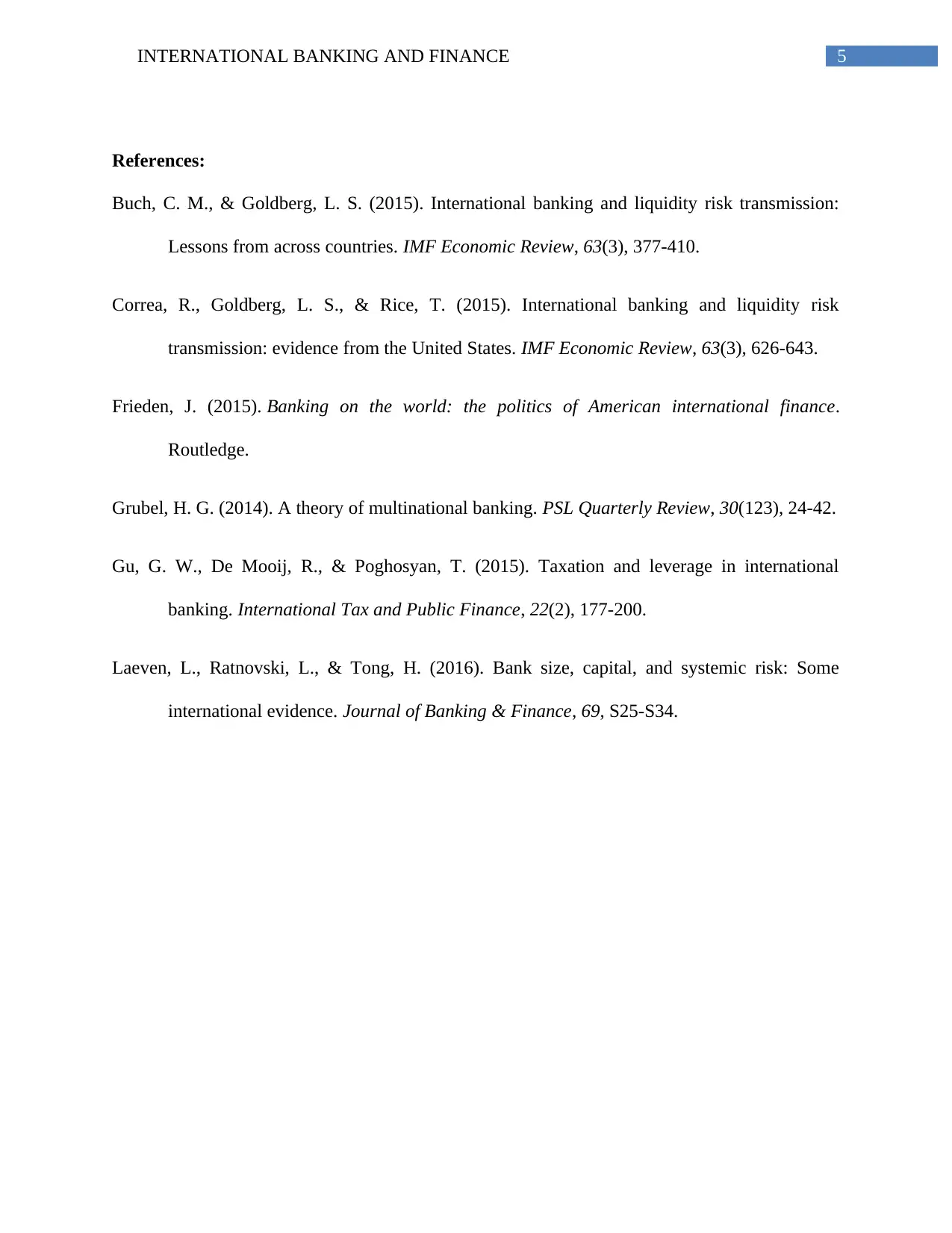
5INTERNATIONAL BANKING AND FINANCE
References:
Buch, C. M., & Goldberg, L. S. (2015). International banking and liquidity risk transmission:
Lessons from across countries. IMF Economic Review, 63(3), 377-410.
Correa, R., Goldberg, L. S., & Rice, T. (2015). International banking and liquidity risk
transmission: evidence from the United States. IMF Economic Review, 63(3), 626-643.
Frieden, J. (2015). Banking on the world: the politics of American international finance.
Routledge.
Grubel, H. G. (2014). A theory of multinational banking. PSL Quarterly Review, 30(123), 24-42.
Gu, G. W., De Mooij, R., & Poghosyan, T. (2015). Taxation and leverage in international
banking. International Tax and Public Finance, 22(2), 177-200.
Laeven, L., Ratnovski, L., & Tong, H. (2016). Bank size, capital, and systemic risk: Some
international evidence. Journal of Banking & Finance, 69, S25-S34.
References:
Buch, C. M., & Goldberg, L. S. (2015). International banking and liquidity risk transmission:
Lessons from across countries. IMF Economic Review, 63(3), 377-410.
Correa, R., Goldberg, L. S., & Rice, T. (2015). International banking and liquidity risk
transmission: evidence from the United States. IMF Economic Review, 63(3), 626-643.
Frieden, J. (2015). Banking on the world: the politics of American international finance.
Routledge.
Grubel, H. G. (2014). A theory of multinational banking. PSL Quarterly Review, 30(123), 24-42.
Gu, G. W., De Mooij, R., & Poghosyan, T. (2015). Taxation and leverage in international
banking. International Tax and Public Finance, 22(2), 177-200.
Laeven, L., Ratnovski, L., & Tong, H. (2016). Bank size, capital, and systemic risk: Some
international evidence. Journal of Banking & Finance, 69, S25-S34.
⊘ This is a preview!⊘
Do you want full access?
Subscribe today to unlock all pages.

Trusted by 1+ million students worldwide
1 out of 6
Related Documents
Your All-in-One AI-Powered Toolkit for Academic Success.
+13062052269
info@desklib.com
Available 24*7 on WhatsApp / Email
![[object Object]](/_next/static/media/star-bottom.7253800d.svg)
Unlock your academic potential
Copyright © 2020–2025 A2Z Services. All Rights Reserved. Developed and managed by ZUCOL.




